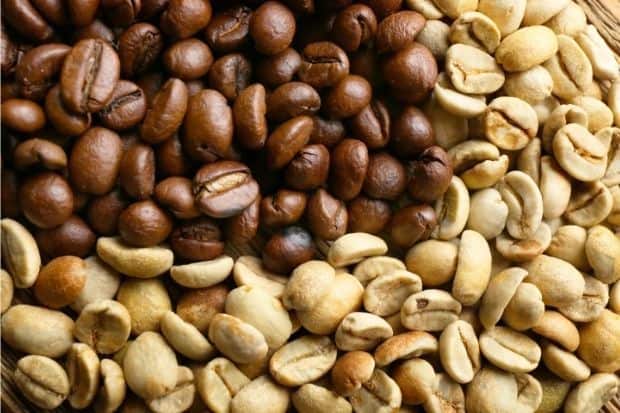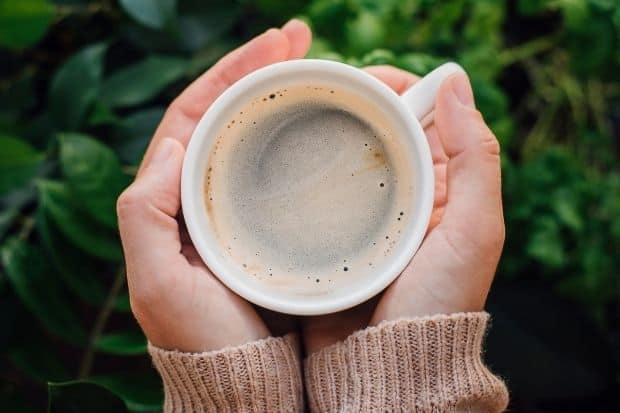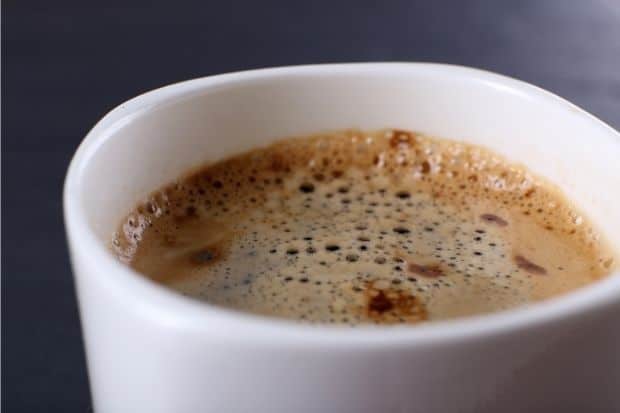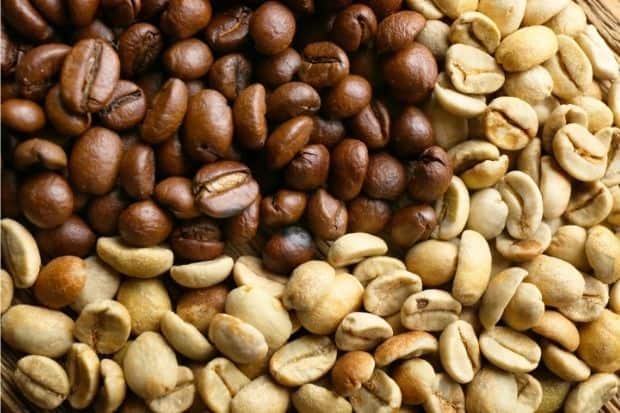Just so you know, as an Amazon Associate we earn from qualifying purchases made via bold red links, buttons or images.
Last Updated on December 3, 2023
In the past few years, a particular coffee trend has started to pick up popularity. With more home baristas trying their hand at making their own coffee, more and more people are starting to make white coffee.
White coffee is roasted at a much lower temperature, with a shorter roasting time, than typical coffee beans. The result is a coffee bean that can be ground and brewed into a unique cup of coffee with a slightly nutty flavor that is quite different from your regular coffee.
But what makes white coffee so special? Why should you try making your own? We’re here to answer all these questions in our ultimate white coffee guide.
What is white coffee?
White coffee is produced by roasting raw green coffee beans about halfway through, at a much lower temperature than dark roasts. The resulting beans have a beige color.

Some coffee roasters who have picked up the white coffee trend report roasting their beans at around 300 degrees. For comparison, blond roasts will often be roasted at 420 degrees, while darker roasts will range up to 475 degrees.
The lower temperature roast gives the coffee bean a much lighter hue, and that’s why it’s called white coffee. The real key to white coffee is that the lower degree of roasting means the beans retain a higher quantity of caffeine. The result is a higher concentration of caffeine per cup.
Where is white coffee grown?
There is a common misconception that the beans that brew white coffee are grown in certain special parts of the world. The reality is that white coffee beans aren’t that unique in themselves; it’s all in how you roast them!
In modern coffee drinking, there are two basic kinds of coffee beans: Robusta and Arabica.
Robusta beans are often used in instant coffee, espresso, and white coffee blends because of their higher caffeine content.
Arabica beans are more commonly used when producing standard coffees, and they tend to retain a more significant amount of flavor in the bean.
While Robusta and Arabica beans each have their own unique flavor profiles, both can be used to create white coffee. The key is to roast the beans at a lower temperature to maintain those unique elements that make white coffee special.
White coffee vs. black coffee
So what sets white coffee apart from your average black coffee? There are several elements to consider, such as caffeine levels, antioxidants, and taste profile.
Caffeine levels
As white coffee beans are roasted at a much lower temperature, more caffeine is retained within the bean itself. This means that you will get a much higher caffeine kick in your white coffee than you would with a traditionally brewed cup using a darker roast.
In fact, some white coffee drinkers judge the caffeine kick of their white coffee to be one-and-a-half times as strong as their traditional black coffee.
Antioxidants
The process of roasting beans diminishes the quantity of antioxidants in coffee. This roast level change means that more antioxidants are retained with white coffee than with “traditional” brews. That’s not bad news for your body!
Antioxidants in coffee act as anti-inflammatory agents, which can help reduce the risk of heart disease. They have even been shown to provide protection against cancer by detoxifying potential carcinogens that you may ingest with your daily food consumption.It’s always nice to know that your morning kick comes at no harm to your body.
White coffee taste
The taste of coffee is in the eye—or the tongue—of the beholder, but we can make a few generalizations about white coffee.
Because it is produced at a lower temperature than most other roasts, it tends to produce a much milder flavor in the cup. This makes it an excellent choice for those who like their coffee on the lighter side but don’t want to sacrifice in the caffeine department.

Roasting at those low temperature means the natural sugars within the coffee bean don’t caramelize as they would in a darker roast, eliminating stronger, bitter notes from your coffee.
Many white coffee drinkers also report a nutty or toffee-like flavor to their roasted beans. This could be due to the lower roasting temperature. Because of this, it is much easier to avoid a burned flavor in your white coffee than with other roasts.
Benefits of white coffee
One of the best things about white coffee is that you get all the benefits of other caffeine drinks without any additives. Whether you’re looking to cut calories, or just want to take in the highest caffeine content possible, white coffee has it covered.
Cuts calories
Enjoying a cup of morning joe has never been so waist-friendly. You can cut out all the unnecessary calories and fat that your body doesn’t need by drinking white coffee. Some traditional morning drinks, such as Frappuccinos or mochas, can total up to 400 calories per serving.
A cup of white coffee only contains two to five calories, aside from sugar that you add, so you are getting the same caffeine fix with less caloric intake.
High in caffeine
If you’re looking for a low-calorie, high-caffeine drink to jump start your day, white coffee is an excellent choice. With a caffeine level that’s 50 per cent higher than traditional coffee, there’s no denying that it will get you going. That extra boost will definitely start your morning off right.
No additives
If you’re looking to cut back on additives and preservatives, white coffee is also a great choice. This isn’t because the taste of white coffee itself is purer (although it can be); it’s because other roasts that are darker often have additional flavors added in to enhance the taste.
Many of these flavors come from different additives to the beans, such as caramel. However, with white coffee, there’s no need for these additives because it can be flavored naturally with honey or sugar without changing the brew’s flavor.
Antioxidants (including chlorogenic acid)
If you’re looking to take in more antioxidants, white coffee is definitely an excellent choice. Not only are there more antioxidants in this brew than in traditional black coffee beans, but coffee has also been shown to contain quite a bit of chlorogenic acid, which has antioxidant properties all its own.
Chlorogenic acid is an antioxidant molecule that’s believed to help your body burn off fat more quickly (but more research is necessary to prove that). It may also help slow the release of simple sugars into the bloodstream, which can prevent blood sugar spikes and crashes. Other studies have pointed to health benefits of chlorogenic acid, such as reduced risks of diabetes and cardiovascular disease.
Much of the beneficial chlorogenic acid is burned off in the roasting process, but white coffee offers a much lower roasting temperature than other roasts. This means that there is a higher amount of chlorogenic acid in white coffee compared to more traditional coffees, and it will not be burned off as quickly.
So these potential health benefits come with the added benefit of a bright, acidic flavor.
Less harsh on your stomach
For some, the acidity in coffee can be a little harsh. If you’re struggling with stomach aches, acid reflux or heartburn after drinking your morning cup of joe, it may be from the acidity.
White coffees have relatively low acidity, so they’re ideal for people who want the caffeine boost without the stomach problems that come with some coffees.
Does white coffee have any health risks?
There is not much more to say about the health risks of white coffee, because compared to other types of coffee, it’s quite safe. However, there are some things to keep in mind.
When buying white coffee, be sure to avoid any that have any sort of flavoring or sugar added. This can negate some of the health benefits. If you already enjoy flavored coffees, it may not hurt for you to add in a little honey or sugar yourself.
Similarly, just as with black coffee, do not add anything that isn’t water. Many people will add creamers or other diluted forms of dairy to their coffee, but this can increase the number of calories you are drinking considerably.
Always be sure that what you are adding is a calorie-free alternative.
How to brew a cup of white coffee
If you want to enjoy all the benefits of white coffee, the key is to know how to brew it properly. Let’s break down the most common ways that you can brew white coffee, from espresso to drip.
One thing to note is that the when beans are roasted this lightly, they do not soften up nearly as much as they do when roasted darker. That means they will not grind easily. We encourage you to use a high-quality burr grinder to grind these beans, and be advised that if you grind a lot of white coffee, your burrs may wear out sooner.
https://m.media-amazon.com/images/I/519N2-+025L._SL500_.jpg
Ground white coffee beans.
Espresso
Brewing a shot of white coffee espresso follows the same methods as other coffee beans. First, you have to grind the beans, much finer than you would for other brewing methods.
Once you have your beans ground, tamp them into your portfilter. Then, lock the portafilter into place and lock it in securely before turning on your espresso machine.
When the espresso maker is ready, it will begin to dispense water through your portafilter and into the cup below. These shots should only take 30 seconds or so at most, and you can enjoy them just like any other shot of espresso.
A lot of people get white coffee confused with a flat white, which is an espresso drink combining coffee and milk. They’re not at all the same, but you can certainly make a flat white using espresso brewed from white coffee.
Drip method for white coffee
The drip method for white coffee is quite popular because it’s one of the easiest ways to make it at home. You don’t need any extra equipment or special techniques to get started.
First, you will want to grind your beans a little coarser than you would for espresso. Once they are ground, place them directly into your coffee filter. Add water to your drip coffee maker as per your machine’s instructions.
Brew as you would normally, and enjoy.

If you want to go for an iced version of this method, brew the coffee hot as usual but increase your coffee grounds by 50 per cent or reduce your water by one-third. After it’s brewed, pour it into a glass full of ice. The ice will melt into the iced coffee as it cools and bring your drink back to its typical concentration.
Pour-over method for white coffee
Another great way to brew your coffee is the pour-over method. You can use this for a cup of white coffee or a full carafe, and it’s quite easy to do.
Begin by placing a filter in your cone brewer. Once you have done that, add your ground coffee beans into the filter. After heating up your water, you can pour just a small bit into the filter and let it sit for 30 seconds. This will help draw carbon dioxide out of the beans.
Once the water has passed through the filter and into your cup or carafe, fill it back up with more hot water for brewing.
French press method for white coffee
You do not need a special kind of French press to make a cup of white coffee, but you do need to be careful not to use too fine a grind.
If you want the nicest flavor from your brew, it’s best to use a medium or coarse grind rather than an fine one. Once you have ground your beans as needed, simply add them to the bottom of your French press and begin pouring on hot water.
After steeping for four minutes or so, push down on your brewer’s plunger to push the coffee grounds down to the bottom and separate them from your coffee.
White coffee side effects
There are few side effects of white coffee because it contains caffeine just like any other type of coffee. However, if you are sensitive to caffeine, it is best not to consume too much at once as your body might react unexpectedly.
All in all, white coffee can be a great way to get your caffeine fix that provides quite a different experience from the dark roasts you might be used to. If you want that strong kick in the morning, a cup of white coffee can certainly get you going.


